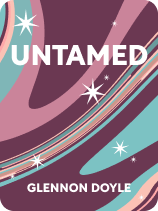

This article is an excerpt from the Shortform book guide to "Untamed" by Glennon Doyle. Shortform has the world's best summaries and analyses of books you should be reading.
Like this article? Sign up for a free trial here .
Are you looking for a helpful overview to Glennon Doyle’s Untamed chapters? Do you need a quick recap of the book?
The Untamed chapters are similar to a blog post format: a personal narrative or reflection, a realization inspired by this reflection, and words of wisdom that you can apply to your life. Doyle’s chapters have these qualities and contain extended metaphors to explain her ideas, lessons, and themes. The extended metaphors help connect the reader to the book’s themes by providing a central image.
Keep reading for a guided overview of Glennon Doyle’s Untamed chapters and to learn from our analysis of the book.
Introduction to Untamed
Do you ever feel that there is a more authentic, primal self within you waiting to be free? Glennon Doyle has felt this way, too—like a wild animal in captivity who was conditioned not to feel, think, or trust herself. She tells her story in the chapters of Untamed, part memoir—covering her personal story of addiction and rehab, falling in love with a woman, leaving her marriage, and rebuilding her life—and part call to action for any woman who feels held captive by society’s rules and expectations. Through exploration of her story, she instructs readers to rebuild their lives using emotion, intuition, and imagination as guiding forces. In this guided overview of the Untamed chapters, we’ll explore Doyle’s journey out of captivity and her lessons for other captive women.
How the Untamed Chapters Are Organized
This book has three parts, each divided into short chapters. The first part introduces Doyle’s concept of captivity and her argument for escaping. The second part introduces her central themes—reexamining her life, being free from society’s expectations, and finding pathways to liberate herself. The third part of the book explores these themes through personal experiences. Many of these experiences involve her intimate relationships and her interactions with her children.
Doyle doesn’t tell her story in chronological order, instead visiting a new theme or personal experience in every chapter. This particular organization can make it difficult to connect her experiences directly to the central themes she introduces in the first section.
Our Approach to the Untamed Chapters
Our guide focuses on what Doyle identifies as the four pathways that free you from a state of metaphorical captivity. We connect each pathway with Doyle’s journey and explore how she has deconstructed her prior beliefs and rebuilt a new life on her terms.
- The first pathway (embracing your emotions) touches on Doyle’s experiences with alcohol addiction and rehab.
- The second pathway (embracing your intuition) explores Doyle’s experiences during a crisis in her first marriage.
- The third pathway (embracing your imagination) explores Doyle’s love story and remarriage.
- The fourth pathway (deconstructing your beliefs) examines the experiences that led Doyle to deconstruct her beliefs.
Doyle’s central concepts that we’ll see in this guide—feminism, empowerment, and reconstructing your life—are well-explored by other thinkers. We’ve therefore extended her ideas with complementary actionables, different perspectives, and supporting research.
Pathway #1: Embracing Emotion
Doyle’s captivity—like most women’s—started as a young girl. As a child, Doyle was very emotional. As Doyle entered young adulthood, she received the message from society and the people in her life that strong emotions were undesirable—she was supposed to be agreeable and well-behaved. Unable to express her emotions or cope with the heartache, pain, anxiety, and depression she experienced as a young woman, Doyle self-medicated with food, drugs, and alcohol.
| Further-Reaching Effects of Numbing Your Emotions In attempting to numb her negative emotions, Doyle numbed all of her emotions—which likely made her ability to cope with negative emotions even worse. In The Gifts of Imperfection, Brené Brown explains why numbing your negative emotions often can backfire in this way. Brown says that your ability to recall positive experiences helps you build resilience—you can get through negative situations by remembering that they won’t last, and you can have happy times. However, when you numb all your emotions to avoid the negative ones, you block yourself from experiencing positive emotions—limiting your ability to draw on positive emotional experiences in times of crisis. |
Embracing Emotion Means Growing
When she became pregnant with her first child, Doyle entered rehab. In rehab, she began to feel her emotions again and realized that she could experience them all, even the painful ones, and survive. (Shortform note: In giving up her coping mechanisms, Doyle was able to clearly see her resilience—a common, and uplifting, experience for people in addiction recovery. In We Are The Luckiest, Laura McKowen writes that she feels lucky to have struggled with addiction because recovery allowed her to know what she was capable of.)
She realized that she could use painful emotions to grow and evolve—to become truly alive. Doyle defines being “alive” as constantly evolving into a more authentic and fully-formed version of yourself. She believes your emotions will provide all the instructions you need to guide you on your journey—and the most challenging emotions are often the most instructive.
(Shortform note: Doyle says that negative emotions can be the most instructive, but in Positivity, author Barbara Fredrickson argues that good emotions do a much better job at broadening your mind and teaching you important truths. Positive emotions raise dopamine levels in your brain—prompting creativity and openness to new experiences. Embrace all your emotions, good and bad, for a well-rounded learning experience.)
Pathway #2: Embracing Intuition
Doyle’s second pathway towards freedom is embracing your intuition, or being guided by a deep sense of inner truth.
Doyle observes that women are conditioned to please and seek approval from others—as a result, they don’t often trust their instincts and search externally for advice and validation. She wanted to find a way to connect with herself deeply to make decisions that were based on her inner wisdom and intuition rather than the opinions of outside sources.
Having landed on the right practice, Doyle no longer feels she has to consult others for advice or validation. Her intuition frees her from being controlled by society’s expectations and empowers her to make her own choices. When making a difficult decision, you can use Doyle’s method for tapping into your intuition:
- Retreat to a quiet place where all you hear is your breath.
- Sink into your consciousness and become aware of a deeper sense of yourself.
- Connect and commune with this version of yourself.
- Ask a question in this mental space and see if you sense a gentle push towards the next step to take.
- Sit and reflect on this new knowledge and insight.
This practice will get you in touch with your intuition, allowing you to make your own choices, confident that your decisions come from a place of strength and inner knowledge.
| Practical Steps for Successfully Accessing Your Intuition It’s important to note that various practices can be useful in accessing your intuition—if Doyle’s process of connecting to a deeper sense of self feels a bit too ambiguous for you to replicate, you might try incorporating more concrete steps into your practice. In The Success Principles, Jack Canfield shares his approach to accessing intuition—similar to Doyle’s practice in some ways, but with several more relatable practices. Canfield’s first recommendation is that you prepare your mind and body for meditation by sitting comfortably and practicing relaxation techniques such as deep breathing. He then recommends that you find a focal point and repeat a single word or phrase (such as “relax” or “I am love”). Repetition can clear your mind and help you focus. Doyle’s practice doesn’t emphasize meditation preparation practices as Canfield does—combining these practices with Doyle’s suggestion to sit in a darkened space may help you get into the deep, reflective mindset required for “sinking into” your inner self. Canfield says that the next step is to shift into a mode in which you are more receptive to messages and intuition. This receptive mode is similar to Doyle’s deep meditative state in which she receives messages from her inner self, but has one significant difference: Rather than asking you to seek an inner voice, Canfield suggests you pay attention to your emotions and physical sensations. These tangible signals can tell you what your intuition is trying to say. |
Pathway #3: Embracing Your Imagination
Doyle’s newfound connection with her emotions and intuition laid the groundwork for her to fully, freely embrace her imagination when her life took an unexpected turn. While on a book tour, Doyle met and unexpectedly fell in love with soccer star Abby Wambach. She describes her experience meeting Abby as love at first sight. When Abby walked into the room, Doyle saw her future path emerging—although she had never met Abby, Doyle could clearly imagine a future as Abby’s partner.
(Shortform note: Studies have shown that the endorphins released when you fall in love—like when Doyle saw Abby—can increase imagination and creativity. However, you don’t have to fall in love to similarly increase your capacity for imagination. Try opening yourself up to new endorphin-releasing experiences, such as traveling to a new place or trying your hand at art.)
Rewriting the Script
Since her life with Abby didn’t follow the script society had written for her, Doyle had to write her own script, imagining the life she wanted and then making that a reality.
From her experience of discovering happiness once she flipped the script, Doyle realized how important it is for women to rewrite their scripts—using their imaginations as a guide to direct their lives. Doyle suggests the following steps for rewriting your script:
- Express your discontent. Be specific about what is wrong and what needs to change.
- Use your imagination to identify what you want. Ask yourself, “What is the best version of my life that I can imagine?”
- Create a picture of it in your mind.
- Write down your desires and discuss them with loved ones.
| Exploring the Steps of Rewriting Your Script Each step to rewriting your script is important and worth exploring in more depth. Aside from the chapters of Untamed, Doyle has also expanded on the process in multiple podcasts, interviews, and speeches—here, we’ll explore her discussion of each step: – Expressing your discontent is a useful starting point because articulating what you are unhappy about and what needs to change challenges the idea that you should always be happy and grateful. – Asking yourself what you want is important because what you want often gets hidden beneath the expectations that others have for you. – Creating a clear picture of your desired future is a powerful technique because you may have never visualized the most beautiful version of your life—and therefore may not even be aware of what you really want. – Sharing your ideas with others can help you feel seen and acknowledged—which can further inspire you to take action. |
Pathway #4: Embracing Deconstruction
At this point in the Untamed chapters, you’re now ready to examine areas of your life where emotion, intuition, and imagination are suppressed. By deconstructing those areas, you can let these powerful aspects of yourself shine. Deconstruction requires dismantling old beliefs and practices that you have inherited from your culture, giving you a clean slate upon which to reconstruct a new life that better reflects your current values and goals. (Shortform note: Deconstructing your beliefs not only allows you to create a new life that’s more aligned with your values, but also allows you to more easily engage in change and creativity. In Think Again, Adam Grant says that the crucial ability to rethink your beliefs allows you to develop new solutions and ideas for breaking free of old mindsets.)
Deconstructing Marriage, Motherhood, and Family Structure
In this overview of the Untamed chapters, we’ll explore how Doyle deconstructed her beliefs and practices about marriage, motherhood, and family in creating her new life with Abby.
Original Beliefs
Doyle learned from her conditioning that the best way a woman can love the people in her life and her community is to selflessly serve others and put her desires last. She tried to be a dutiful wife, a selfless mother, and maintain a traditional family structure.
(Shortform note: You may not be ready—or willing—to completely reject this aspect of your selfless nature. In that case, you might take a slightly different approach: cultivating a balance between selflessness and self-care. By balancing your selflessness with rejuvenating self-care practices, you can both honor your needs and fuel yourself for the emotional work of caring for the people in your life.)
New Beliefs
Marriage: Doyle deconstructed her beliefs about what it meant to be in an intimate relationship. She abandoned the idea that she must be pleasing and performative—instead forming a new belief that she deserves pleasure in her intimate relationships. (Shortform note: While many women feel obligated to put their partner’s needs before their own, rethinking these beliefs can lead to more fulfilling sexual experiences. One way to become more aware of your desires is to check in with yourself before being intimate with another person. A self-check-in can help you assess what you want and can help you express your desires.)
Parenthood: Doyle deconstructed her beliefs about what it meant to be a parent. She wanted to model happiness and fulfillment for them rather than self-sacrifice. (Shortform note: Many authors and researchers agree that seeing happy adults provides important benefits for children. In Modelling Happiness, Reen Rose says that when children see adults being curious, pursuing new ideas, and engaging in enjoyable activities, they witness both what it looks like to be happy and learn skills (such as resiliency, bravery, and confidence). These skills will help children to pursue their happiness as they mature.) Family Structure: She deconstructed her beliefs about family structure. She realized that family structure can diverge from a nuclear family and still provide love, support, and stability. (Shortform note: Doyle’s assumption that the nuclear family should be maintained at all costs likely comes from societal messaging that this family structure is “best”—but studies show that many believe that any family that provides love, protection, and support is “best.” A larger societal trend towards accepting a wide range of family arrangements mirrors Doyle’s experiences. Research shows that an increasing percentage of the American population accepts and supports non-traditional family structures.)
Untamed Chapters Conclusion
The four pathways we have discussed helped free Doyle from captivity. As these four paths converged, they empowered Doyle to reconstruct her life to reflect her truest self in four ways:
- The Pathway of Embracing Emotion: By feeling difficult emotions, she can face the future confidently, knowing that her difficult emotions will help her grow into the person she needs to become. Doyle built a new purpose based on empathy and activism.
- The Pathway of Embracing Intuition: By accessing her intuition, she can understand herself more deeply and feel secure when making difficult decisions. Doyle formed a new understanding of her inner self.
- The Pathway of Embracing Imagination: By envisioning and articulating her deepest desires for the future, she can rewrite her story so that these imaginings can become her reality. Doyle built a new marriage based on imagination.
- The Pathway of Deconstruction: By deconstructing prior beliefs, she can separate herself from social structures and institutions that do not reflect who she is and what she believes. Doyle built a new family, faith, and worldview based on consciousness rather than complacency.
Doyle now lives according to her wildness—her primal self who had been there all along, waiting to be free. She has made a promise never again to abandon herself. She will practice self-love and always trust her instincts, and calls on her readers to once again become wild women.
| Doyle’s Continued Commitment to Her Pathways Doyle continues to embrace the pathways we have explored in this guide—she’s found concrete ways to live into each: – She has a post-it note on her mirror that reminds her to “feel it all” and embrace her emotions. – She continues to be guided by her intuition as she engages in activism through Together Rising and raises money for causes close to her heart. – Doyle lives the life she imagined for herself with Abby. Together they co-host the We Can Do Hard Things podcast, in which they are honest about their daily struggles and how they try to support each other on their respective journeys. |

———End of Preview———
Like what you just read? Read the rest of the world's best book summary and analysis of Glennon Doyle's "Untamed" at Shortform .
Here's what you'll find in our full Untamed summary :
- Glennon Doyle's story of freeing herself from society's rules and expectations
- Why you should rebuild your life using emotion, intuition, and imagination
- A look at how young women are taught to repress their emotions and desires






